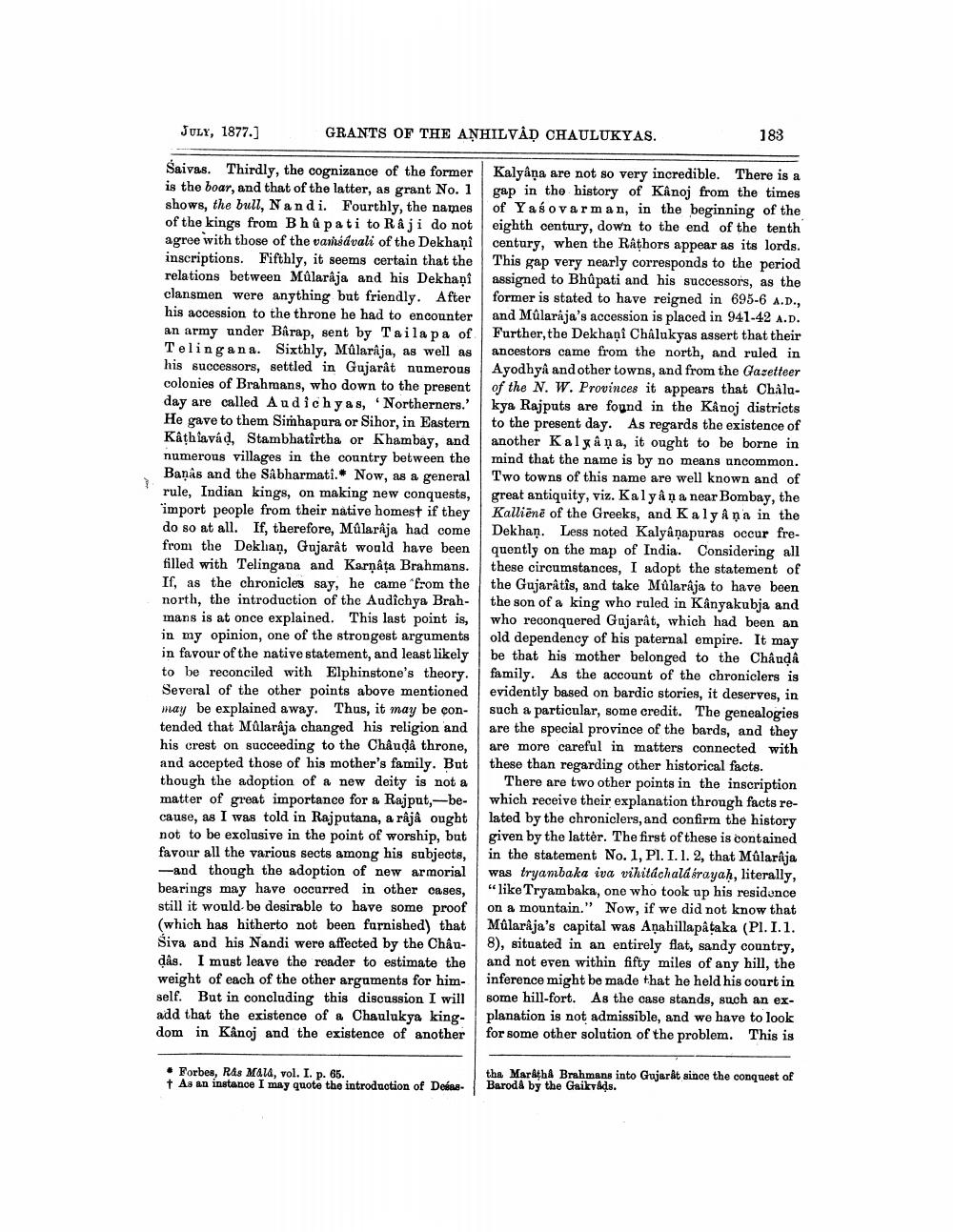________________
GRANTS OF THE ANHILVAD CHAULUKYAS.
JULY, 1877.]
Saivas. Thirdly, the cognizance of the former is the boar, and that of the latter, as grant No. 1 shows, the bull, Nandi. Fourthly, the names of the kings from Bhupati to Râji do not agree with those of the vamsávali of the Dekhani inscriptions. Fifthly, it seems certain that the relations between Mûlarâja and his Dekhani clansmen were anything but friendly. After his accession to the throne he had to encounter an army under Bârap, sent by Taila pa of Telingana. Sixthly, Mûlarâja, as well as his successors, settled in Gujarât numerous colonies of Brahmans, who down to the present day are called Audichyas, 'Northerners.' He gave to them Simhapura or Sihor, in Eastern Kâthlavád, Stambhatirtha or Khambay, and numerous villages in the country between the Banas and the Sâbharmati. Now, as a general rule, Indian kings, on making new conquests, import people from their native homest if they do so at all. If, therefore, Mûlarâja had come from the Deklan, Gujarât would have been filled with Telingana and Karnâța Brahmans. If, as the chronicles say, he came from the north, the introduction of the Audichya Brahmans is at once explained. This last point is, in my opinion, one of the strongest arguments in favour of the native statement, and least likely to be reconciled with Elphinstone's theory. Several of the other points above mentioned may be explained away. Thus, it may be contended that Mûlarâja changed his religion and his crest on succeeding to the Châudâ throne, and accepted those of his mother's family. But though the adoption of a new deity is not a matter of great importance for a Rajput,-because, as I was told in Rajputana, a râjâ ought not to be exclusive in the point of worship, but favour all the various sects among his subjects, -and though the adoption of new armorial bearings may have occurred in other cases, still it would be desirable to have some proof (which has hitherto not been furnished) that Šiva and his Nandi were affected by the Châudâs. I must leave the reader to estimate the weight of each of the other arguments for himself. But in concluding this discussion I will add that the existence of a Chaulukya kingdom in Kanoj and the existence of another
Forbes, Rás Malá, vol. I. p. 65.
† As an instance I may quote the introduction of Desas
183
Kalyâna are not so very incredible. There is a gap in the history of Kânoj from the times of Yasovarman, in the beginning of the eighth century, down to the end of the tenth century, when the Râthors appear as its lords. This gap very nearly corresponds to the period assigned to Bhûpati and his successors, as the former is stated to have reigned in 695-6 A.D., and Mûlaraja's accession is placed in 941-42 A.D. Further, the Dekhanî Chalukyas assert that their ancestors came from the north, and ruled in Ayodhya and other towns, and from the Gazetteer of the N. W. Provinces it appears that Châlukya Rajputs are found in the Kânoj districts to the present day. As regards the existence of another Kalyana, it ought to be borne in mind that the name is by no means uncommon. Two towns of this name are well known and of great antiquity, viz. Kalyan a near Bombay, the Kalliene of the Greeks, and Kalyana in the Dekhan. Less noted Kalyanapuras occur frequently on the map of India. Considering all these circumstances, I adopt the statement of the Gujaratis, and take Mûlarâja to have been the son of a king who ruled in Kanyakubja and who reconquered Gujarât, which had been an old dependency of his paternal empire. It may be that his mother belonged to the Châuḍâ family. As the account of the chroniclers is evidently based on bardic stories, it deserves, in such a particular, some credit. The genealogies are the special province of the bards, and they are more careful in matters connected with these than regarding other historical facts.
There are two other points in the inscription which receive their explanation through facts related by the chroniclers, and confirm the history given by the latter. The first of these is contained in the statement No. 1, Pl. I. 1. 2, that Mûlaraja was tryambaka iva vihitáchaláérayaḥ, literally, "like Tryambaka, one who took up his residence on a mountain." Now, if we did not know that Mûlaraja's capital was Anahillapâtaka (Pl. I. 1. 8), situated in an entirely flat, sandy country, and not even within fifty miles of any hill, the inference might be made that he held his court in some hill-fort. As the case stands, such an explanation is not admissible, and we have to look for some other solution of the problem. This is
tha Maratha Brahmans into Gujarat since the conquest of Baroda by the Gaikvaḍs.




